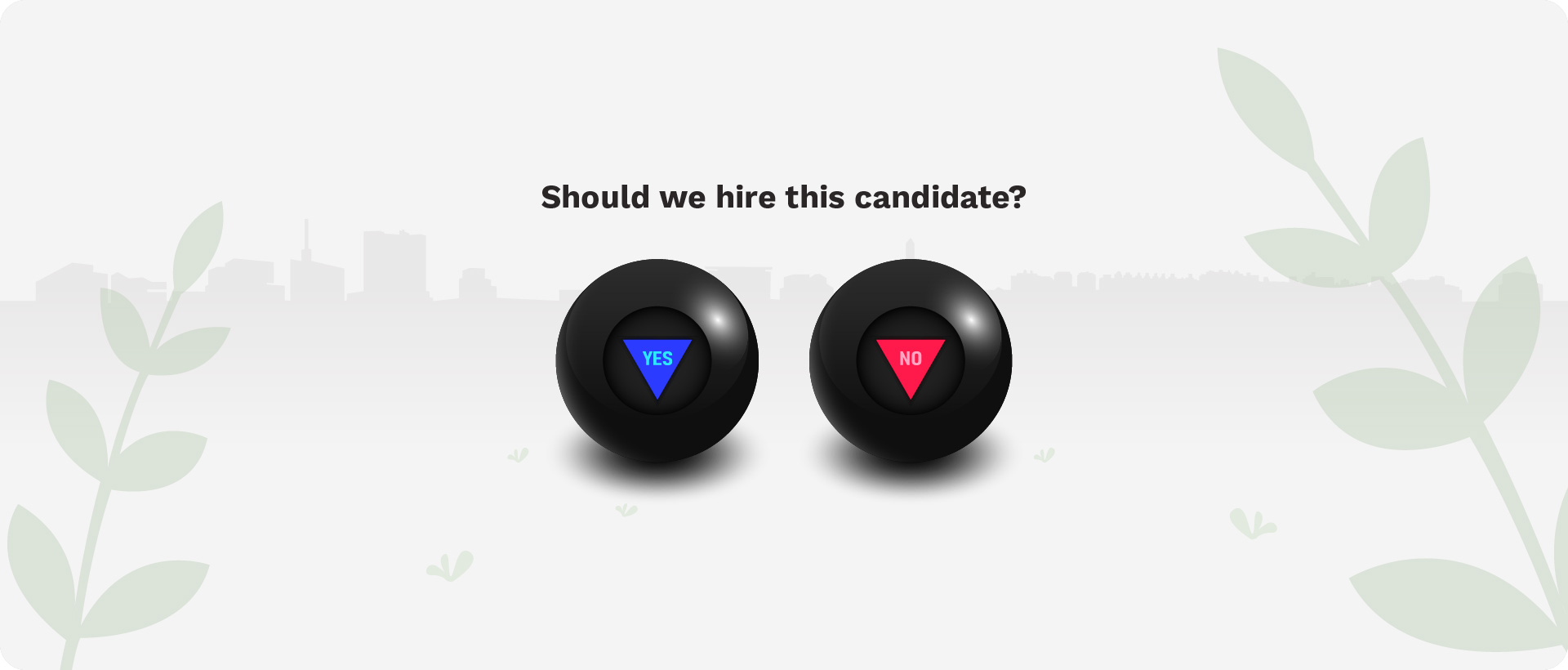At Harver, we’ve seen a lot of questionable hiring practices in our time—but few are quite as pervasive, or as problematic, as the rise of “secret tests” and personality shortcuts that claim to measure something meaningful about a candidate without any scientific backing.
While we can all agree that resumes are not predictors of success in a role, many people believe these tests are the keys to unlocking unseen candidates’ true values and personalities.
You may have encountered some of them:

The Salt and Pepper Test: In this scenario, an interviewer observes whether a candidate seasons their food before tasting it during a lunch interview. If they do, they’re labeled impatient or impulsive.
The Problem: It lacks predictive validity, introduces cultural bias (many cultures season food as a norm), and says far more about the interviewer’s preferences than the candidate’s job fit.

The Water Test: Some interviewers use whether a candidate accepts a drink as a pseudo-assessment of confidence or social grace. If they decline, it’s interpreted as nervousness or formality.
The Problem: Factors like lipstick, nerves, or unfamiliarity with office culture can explain this behavior better than some assumed character flaw.

The Coffee Cup Test: If a candidate does accept a drink at the start of an interview, they are then sometimes also tested on whether they return their empty cup to the kitchen at the end. Those who do are deemed responsible team players. Those who don’t? Not hired.
The Problem: It confuses social behavior with job performance and ignores cultural formality or power dynamics (e.g., candidates trying not to overstep or “clean up after themselves” in a host’s space).

The Animal Question: Another classic? “If you were an animal, what would you be?” It’s often framed as a test of creativity or self-awareness.
The Problem: In practice, it’s a game of interpretation. A lion might sound assertive to one interviewer and arrogant to another. A golden retriever could imply loyalty—or lack of ambition. What it doesn’t do is provide consistent, role-relevant data.
These types of assessments introduce noise, not clarity. They make assumptions about personality and potential based on irrelevant behaviors that may be influenced by culture, neurodivergence, or the social discomfort of the interview setting. Imagine rejecting a brilliant problem-solver because they didn’t offer to rinse a mug. That’s not selection—that’s superstition.
Worse, candidates often don’t even know they’re being assessed. That creates a serious ethical concern—and one that undermines trust in your hiring process.
The Risks Are Real
Unscientific hiring tests don’t just waste time—they risk bias, reduce diversity, and open your organization up to legal challenges. Many of these practices reflect the interviewer’s worldview, not the competencies required for the job. By relying on them, you institutionalize subjectivity and limit the diversity of thought, experience, and background that actually drives performance.
On top of that, hiring practices must be defensible, standardized, and clearly job-related. That means being able to demonstrate that your assessments are valid (they measure what they’re supposed to) and reliable (they yield consistent results). Tests like the salt and pepper test or the animal question simply don’t meet the bar.
Even if a quirky “test” feels clever or personal, ask yourself: Can you defend it in court? Does it produce actionable insights? Would a candidate from a different background interpret it the same way—or even know they were being evaluated?
If not, it’s time to upgrade your approach.
What These Tests Really Reveal
Here’s the bigger red flag: these pseudo-assessments say less about the candidate and more about your organization.
If a company is comfortable making snap judgments based on drink choices or seasoning habits, what other unspoken rules or biased evaluations are happening behind the scenes? This creates a psychologically unsafe environment—one where candidates (and eventually employees) constantly second-guess how they’re being perceived. That’s not how you attract top talent. It’s how you erode trust before day one.
The Hidden Cost: Excluding Neurodivergent Talent
Unstructured, unscientific evaluations are especially harmful to neurodivergent candidates—those with ADHD, autism, anxiety, or other cognitive differences—who may navigate social cues differently. When hiring hinges on subjective interpretations of behavior rather than ability, you risk filtering out uniquely talented individuals simply because they didn’t conform to an arbitrary norm.
The result? Missed innovation, limited diversity of thought, and teams that are less equipped to solve complex problems. Great talent doesn’t always look or act like you expect—and that’s exactly why your hiring process needs to be structured, inclusive, and fair.
Beyond ethics and fairness, there are legal implications to consider. Under the Americans with Disabilities Act (ADA), employment practices must be free from discrimination and provide reasonable accommodations for individuals with disabilities—including many neurodivergent conditions.
When hiring decisions are made based on non-standardized, unvalidated assessments—or worse, secret “tests”—you open your organization to serious legal risk. These practices are difficult to defend because they’re neither job-related nor consistently applied. Courts and regulatory bodies expect employers to use objective, validated tools to make hiring decisions. If you can’t clearly explain how your process predicts job performance, it’s not just ineffective—it may be unlawful.
Harver’s Science-Backed Alternative
At Harver, we’ve built our assessments around one core principle: real-world, role-relevant, science-backed evaluation. Our goal is to help employers understand candidates holistically—without guesswork, gimmicks, or bias.
Our suite of Predictive Assessments are designed to measure what matters to create a complete picture of a candidate:
- Behavioral & Cognitive Assessments: We measure 22 core traits based on the gold-standard Big Five model, helping organizations understand how someone’s temperament might fit into a team or specific environment.
- Situational Judgment Tests (SJTs): These simulate real-life scenarios relevant to the role, revealing how a candidate is likely to behave on the job—not just how they act over lunch.
- Job Knowledge and Skills Assessments: Evaluate what a candidate knows and can do, whether it’s computer proficiency, tech support troubleshooting, or sales acumen.
But we also know that even the best assessments are only part of the picture. That’s why Harver provides standardized interview guides to help interviewers dive deeper, structure the conversation around competencies that matter, and ensure consistency across every candidate interaction.
These guides help:
- Reduce subjective “gut feel” decisions
- Ask relevant, competency-based questions
- Avoid missed opportunities or misinterpreted signals
And most importantly, the platform provides a standardized experience that reduces bias and levels the playing field for all candidates.
Our goal is to empower organizations to hire faster and fairer, not rely on folklore to fill roles. The candidates we hire today shape the organizations we become tomorrow. We owe it to them—and to ourselves—to make those decisions based on data, not dinner manners.
A Better Way Forward
Hiring is hard. It’s natural to look for creative shortcuts. But when creativity comes at the cost of fairness or validity, it’s time to reassess.
Your hiring process should reflect the values of your organization. When you use unscientific tests to make decisions—especially secret ones—you risk more than a bad hire. You risk alienating great candidates, harming your employer brand, and building a team that looks and thinks just like the people already in the room.
Assessments should be grounded in what actually predicts performance. Because ultimately, hiring isn’t about how someone seasons their steak or where they set their cup. It’s about whether they can do the job—and thrive while doing it.
Let’s leave the salt and pepper at the table. And bring some science back to hiring.


